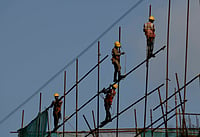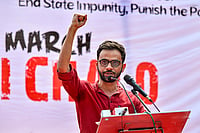
Bihar’s 2025 election narrative is dominated by the NDA’s repeated use of the “Jungle Raj” label against the RJD, despite a sharp rise in crime under its own tenure.
Crime in Bihar has surged — including kidnappings and robberies — even as cases of dacoity and extortion linked to the Lalu–Rabri era have declined.
The continued presence of candidates with serious criminal backgrounds underlines persistent concerns over political violence and coercion in Bihar.
As the Bihar Assembly elections approach, leaders of the National Democratic Alliance (NDA) have repeatedly invoked the specter of “Jungle Raj”. Prime Minister Narendra Modi has described the Rashtriya Janata Dal (RJD) and the Congress as embodying the “five identities” of Bihar’s Jungle Raj — katta (country-made guns), kroorta (cruelty), katuta (resentment), kushasan (misgovernance), and corruption.
However, this is where the data flips the script.
Crime in Bihar rose by around 80 per cent from 2015 to 2024, while the average increase for the nation was just 24 per cent in the same period. From 2015 to 2022, Bihar reported a 65.9 per cent increase in kidnappings, and a 39.2 per cent rise in robberies. Conversely, cases of dacoity and extortion, which peaked during the Lalu Prasad Yadav era, have declined significantly.
Chief Minister Nitish Kumar, meanwhile, continues to frame the contest as a choice between disorder and order, a “then versus now.” Through this narrative, the NDA has sought to position itself as the antithesis, a symbol of inclusivity and development, encapsulated in the slogan ‘Sabka Saath, Sabka Vikas’.
The shadow of his father’s “Jungle Raj” looms large over Tejashwi Yadav as he strives to free himself from its lingering stigma. The NDA has wielded this narrative with such intensity that, during a key rally in Samastipur, the birthplace of Karpoori Thakur, Narendra Modi invoked the term “Jungle Raj” 17 times in his 45-minute address.
The Rise of NDA
Despite being governed by the NDA for most of the last two decades, Bihar’s law-and-order situation continues to raise concerns. According to NCRB data for 2023, the state ranked second highest in the country for murder cases, with 2,862 incidents and 2,882 victims.
Bihar also recorded the highest number of attacks on police and government officials, with 371 reported assaults. The overall crime rate per 1 lakh population has risen steadily, from 211.3 in 2020 to 277 in 2022–23, highlighting a worrying upward trend in criminal activity.
However, adjusted for population, Bihar falls below the national average in many categories of violent crime per lakh. Yet offences such as grievous hurt (13.1 cases per lakh) and kidnappings (9.4 per lakh) remain above the national averages of 6.2 and 7.8, respectively.
Nitish Kumar and his allies have long presented Lalu Prasad Yadav’s era of lawlessness as a moral baseline for their campaign. Their narrative emphasises the eradication of institutionalised violence and the restoration of public safety, particularly for women, a key voter base for Nitish.
While Yadavs and minorities view Lalu Yadav’s tenure as a transformative period that emphasised symbolic social justice and gave them a political voice, the NDA’s narrative portrays the same era as one marked by lawlessness and instability. The NDA’s messaging remains simple yet powerful.
In the 2024 General Elections, Bihar saw 47 complaints of booth capturing, a sharp decline compared with 4,995 cases in 1998. While electoral violence and election-related deaths have decreased, the presence of candidates with criminal backgrounds often referred to as ‘Bahubalis’, remains significant.
According to an analysis by the Association for Democratic Reforms (ADR) and Bihar Election Watch for Phase I of the 2025 Assembly polls, 423 of 1,303 candidates have declared criminal cases, with 354 facing serious charges including murder, attempted murder, and crimes against women.
This was underscored when gangster-turned-politician Dular Chand Yadav was shot dead while campaigning near Patna. The incident took place in Mokama, about 100 km from the city, where Yadav, recently aligned with a Jan Suraaj Party candidate, was reportedly involved in a clash with political rivals.
The Counter
The period from 1990 to 2005, when Lalu Prasad Yadav and later his wife Rabri Devi held power in Bihar, is generally associated with Jungle Raj. During these fifteen years, the state also experienced a brief spell of President’s Rule in 1999 and a short-lived government under Nitish Kumar in 2000.
Kidnappings for ransom and caste-based violence peaked in Bihar during the latter years of the RJD’s rule. Between 2001 and 2004, under Chief Minister Rabri Devi, the Bihar Police registered 1,527 cases of kidnapping for ransom — a stark contrast to the 429 cases recorded between 2006 and 2009. The police and administrative machinery were often seen as complicit, enabling an atmosphere of fear and impunity. This wave of lawlessness drove many upper-caste families and businesspeople out of the state, while others met gruesome ends.
Between 1991 and 2001, Bihar witnessed 58 caste-based massacres, claiming 566 lives, among them, 343 Scheduled Caste and Other Backward Class agricultural labourers and 128 upper-caste landlords. Some of the most infamous of these incidents include the Bara massacre (Gaya, 1992), in which 34 upper-caste landlords were killed; the Lakshmanpur-Bathe massacre (Jehanabad, 1997), where 58 Scheduled Caste agricultural labourers lost their lives; and the Senari massacre (Jehanabad, 1999), which claimed 35 upper-caste victims.
The 1990s also witnessed unprecedented levels of electoral violence in Bihar. Incidents of murder, loot, arson, kidnapping, intimidation, and other crimes became routine during election periods. According to official reports, 641 people lost their lives in poll-related violence across nine elections between 1990 and 2004, including 196 deaths during the 2001 panchayat elections, held after a 23-year hiatus.
Many of these casualties took place in the run-up to the polls, on polling day itself, or even in the aftermath of the results.
The RJD has struggled to craft a compelling counter to the NDA’s enduring “Jungle Raj” narrative, and the legacy of Lalu Prasad Yadav’s rule continues to weigh heavily on Tejashwi Yadav’s shoulders. In response to this persistent campaign of mistrust, the party has advanced two key arguments.
First, Tejashwi has repeatedly asserted that the so-called “Jungle Raj” did not return during the RJD’s brief stints in power in 2015 and 2022. Second, the RJD argues that the term itself is politically weaponised to divert attention from the social justice gains achieved during Lalu Prasad Yadav’s tenure.
The party has also sought to draw attention to the rising crime rates under Nitish Kumar’s government. Yet, with Lalu’s corruption scandals continuing to dominate public memory, the RJD has struggled to construct a persuasive and credible counter-narrative.
What was the ‘Jungle Raj’?
The term “Jungle Raj” refers to an era of lawlessness and heightened crime rates in Bihar, consistently above the national average. Originating in the 1990s, when Lalu Prasad Yadav first assumed power, the term came to encapsulate a range of issues, from administrative breakdown and rampant kidnappings to caste-based massacres.
It entered Bihar’s social and political lexicon following a remark made on 6 August 1997 by Justices Dharampal Sinha and V. P. Singh of the Patna High Court. During a hearing of a contempt petition filed by social activist Krishna Sahay, concerning the deteriorating civic conditions in Patna, the division bench observed: “It is worse than the Jungle Raj, and there is no regard for court directions or public interest.”
These statistics reveal the grim reality of how violence and coercion were deployed as instruments of political control. Looting of ballot boxes, booth capturing, and demands for re-polls became disturbingly common. The Lok Sabha elections in Patna were countermanded twice, in 1991 and again in 1998. During the 1998 elections, two dozen legislators, including ministers, were caught capturing booths, forcing re-polling in 4,995 booths across the state. This trend was attributed to the inclusion of Bahubali leaders into the party’s ecosystem. The introduction of EVMs in 2004 brought no respite, as news of EVMs destroyed by miscreants during the process of electioneering made headlines.
As Bihar approaches the 2025 Assembly elections, the contest is shaped by memories, current conditions, and public perceptions. While the NDA emphasises law and development, the RJD seeks to highlight its past social justice achievements. Crime trends under both administrations provide ammunition for each side, and the outcome will likely depend on which narrative resonates most with voters.





























